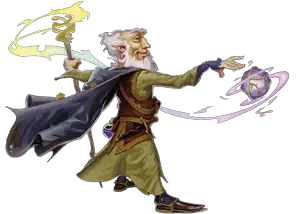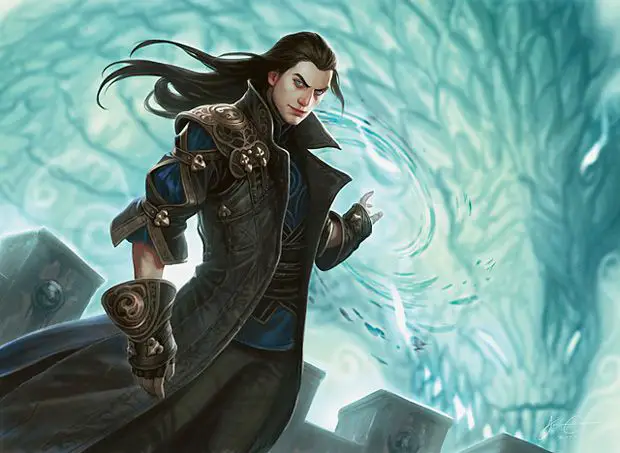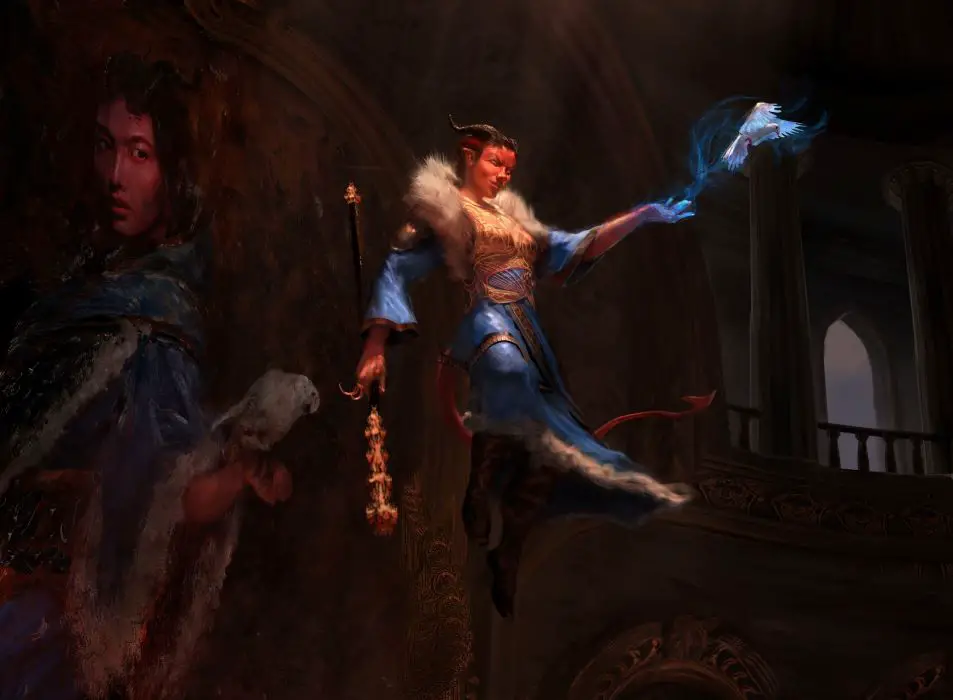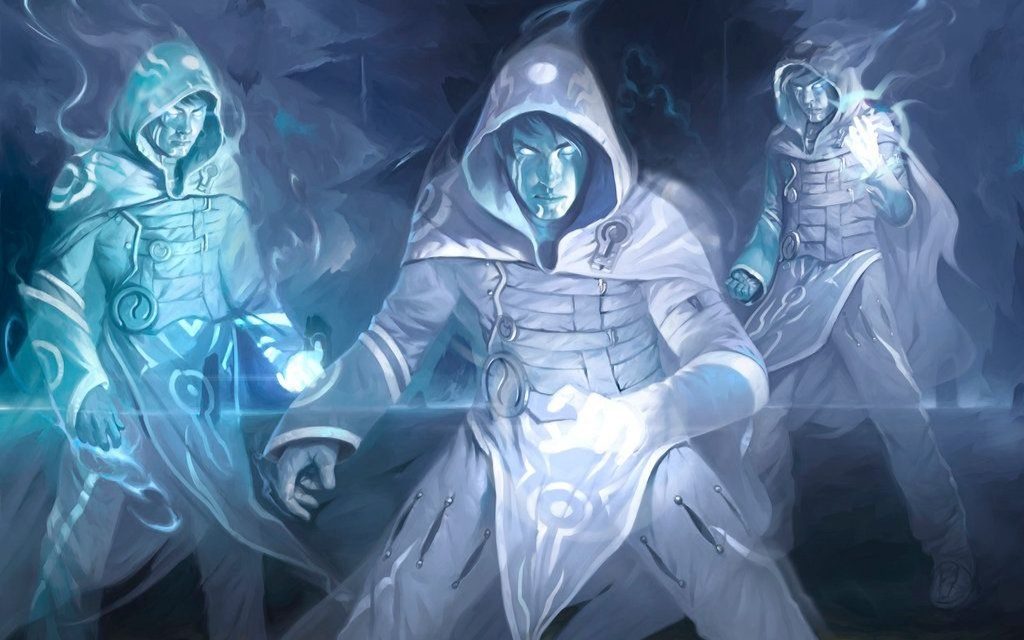Specializing in magic that deceives and confuses their enemies, you should never underestimate the Illusion Wizard.
After all, you can bet that these characters will always have plenty of tricks up their sleeve!
If you’re ready to dive into the trickiest school of magic, this is for you.
This is the full guide to the Illusion Wizard in D&D 5e!
What is the Illusion Wizard in D&D 5e?
A clever disguise, the loud roar of a nonexistent dragon ahead, or even some truly incredible shadow puppets…
It might be easy to dismiss illusion magic as just being a bunch of gimmicks. In fact, Illusion Wizards are counting on others making that exact mistake!
With creativity and a knack for stirring up confusion and chaos, Illusion Wizards are certainly no gimmick!
Of course, this power to fool others with magic tends to manifest in some distinct ways.
In the hands of a Wizard who is more playful, illusion magic can be endlessly entertaining and effortlessly dazzle audiences of any age.
Those who are more practical-minded, on the other hand, understand that a well-placed misdirection can undo all of a foe’s plans. This creates openings for the Wizard and their party to fight or flee as necessary.
Though, of course, there are others who are drawn to the dark side of illusion magic…
Weaving webs of deceit, Illusion Wizards can act as shadowy puppet masters behind entire organizations or even kingdoms!
Wherever your Wizard falls on this spectrum, one thing is for certain: enemies (and possibly even allies) will have a hard time determining between what is real and what are your own manipulations.
The Illusion Wizard is one of eight Wizard subclasses that appear in the 5e Player’s Handbook.

Role in the Party
One of the most interesting things about Illusion Magic in D&D 5e is that it has a pretty wide range of applications.
As a specialist in this school, the Illusion Wizard similarly brings a wide range of capabilities to their party.
First and foremost, Illusion magic brings a great deal of utility to the table. This is especially true in roleplaying scenarios where certain uses can really shine.
Examples include:
- Disguising yourself to infiltrate an organization or exclusive establishment.
- Throwing your voice to make pursuing enemies “chase you” in the wrong direction.
- Convincing would-be threats that a bigger threat is just around the corner.
- Summon an illusion of an intimidating figure as your bodyguard who is waiting just outside during a negotiation.
Other illusion spells and features are more defensive in nature.
These options provide you with ways to inflict conditions (like blindness, incapacitation, or fear) on enemies, which can be used to make a quick getaway or strike while you’ve got the upper hand.
Of course, we also can’t forget how powerful being able to turn invisible is!
And yet there are still some illusion spells that are so real that they’re able to actually harm others. These typically deal psychic damage, which tends to be very reliable!
All of this means that the Illusion Wizard is able to make a huge impact with unique contributions to their party in nearly any situation.
The only real limit is your own creativity!
Illusion Wizard Features 5e
Illusion Wizards have dedicated their lives to the study of arcane magic but specialize in the school of Illusion.
Because they have such a deep understanding of this magic and its power, they’re capable of more powerful illusion magic than other Wizards.
This is reflected in the Illusion Wizard’s class features.
Let’s dive in!
You Might Like: The Schools of Magic in D&D 5e Explained
Illusion Savant (Level 2)
As a specialist in Illusion magic, you’re more efficient when it comes to adding illusion spells to your spellbook.
The gold and time you must spend to copy an illusion spell into your spellbook is halved.
As a Wizard, your spellbook is your single most important possession. You will constantly be looking to learn new spells and add them to your precious spellbook.
Of course, this does take time, money, and a bit of luck when you’re looking for specific spells to copy into your book.
Thankfully, the time and gold cost for copying illusion spells is cut in half for you!
Note that you’re not only limited to learning illusion spells. In fact, it’s still a very good idea to pick up some standbys like Fireball or Misty Step for when illusions aren’t the best option!
I’ll be releasing an article soon that will cover using and managing the Wizard’s spellbook in more detail, so stay tuned for that.
I strongly recommend checking out my comprehensive guide to Using and Managing the Wizard’s Spellbook. It’s truly the most important thing for any Wizard player to know!
Improved Minor Illusion (Level 2)
In the right hands, the Minor Illusion cantrip can be useful. Naturally, the Illusion Wizard’s expertise lets them take this even further!
You learn the Minor Illusion cantrip. If you already know this cantrip, you learn a different wizard cantrip of your choice. The cantrip doesn’t count against your number of cantrips known.
When you cast minor illusion, you can create both a sound and an image with a single casting of the spell.
Normally, Minor Illusion lets you produce either a sound OR an image. But this improved version of the cantrip lets you add BOTH sounds and images to your illusion!
This might seem like a very small thing but remember what I said earlier: the school of Illusion is all about creativity.
Being able to have both sound and visuals in your illusions makes them more believable and greatly expands what you’re capable of making others believe.
Don’t ignore the problem-solving (or problem-creating!) potential of this deceptive cantrip!

Malleable Illusions (Level 6)
Illusions can be handy, but they tend to be pretty static. By that, I mean that they pretty much just do whatever you intended for them to do.
In situations where you need things to change, they can potentially give themselves away.
Even something as simple as an illusion of a person’s hair not blowing while a heavy wind gust sets in can spoil the entire thing.
So, let’s step it up with Malleable Illusions!
When you cast an illusion spell that has a duration of 1 minute or longer, you can use your action to change the nature of that illusion (using the spell’s normal parameters for the illusion), provided that you can see the illusion.
Once again, this lets you step up how believable your illusions are.
Using the example above, you can now have the illusionary person’s hair blow in the wind. They might shift their weight and hold their arm over their face as the wind gust blows.
To anyone who doesn’t decide to poke this “person” or otherwise investigate closely, it would appear to be a normal person behaving in a normal way.
Of course, this also works with much larger spells and in much larger ways as well.
Perhaps the effect you’re creating with Hallucinatory Terrain isn’t getting the result that you had hoped for. Maybe people aren’t properly panicking about the earthquake, but what if that causes a volcano to begin erupting instead?
What if you had summoned an illusion of a cat, but you want to give someone a reason to never sleep again?
As they lean down to pet the cat, you can have the cat “turn into” a banshee and begin screeching as it flies around the person.
Now that’s a story for them to tell their therapist!
Illusory Self (Level 10)
Few tricks are as important as the one you play that saves your life.
After all, Wizards are squishier characters who tend to have mixed feelings about ending up on the business end of an enemy’s battleaxe!
You can create an illusory duplicate of yourself as an instant, almost instinctual reaction to danger.
When a creature makes an attack roll against you, you can use your reaction to interpose the illusory duplicate between the attacker and yourself.
The attack automatically misses you, then the illusion dissipates.
Once you use this feature, you can’t use it again until you finish a short or long rest.
Once per rest, this is an excellent feature for saving your bacon!
Now, hopefully, you’re not finding yourself getting charged at by enemies too often. As we know, Wizards tend to prefer the safer backlines of the party rather than standing up front and center.
But it’s inevitable that the occasional enemy will break through your frontline or try to ambush you from behind.
What makes this so special is that it turns the attack into a guaranteed miss.
Used cleverly, you could make your enemy completely waste a critical hit or a special ability that they can only do a certain number of times per day!
Feel free to point and laugh when your attacker realizes what you’ve done!
Illusory Reality (Level 14)
Up to this point, your illusions have been getting more and more believable. You’ve no doubt confused and fooled countless people by now.
But things are about to get even better!
Now, the line between illusion and reality gets even more blurred!
When you cast an illusion spell of level 1 or higher, you can choose one inanimate, nonmagical object that is part of the illusion and make that object real.
You can do this on your turn as a bonus action while the spell is ongoing.
The object remains real for 1 minute.
For example, you can create an illusion of a bridge over a chasm and then make it real long enough for your allies to cross.
The object can’t deal damage or otherwise directly harm anyone.
This makes the Silent Image spell particularly powerful for you. It’s low-level and can be used to create tons of things, which means it’s very efficient for your spell slots.
But now you can make it real!
While you can’t directly harm people with the illusions that you create and make real with this, it can still be effective for the old “bait and switch.”
So, unfortunately, you won’t be able to summon the illusion of a hwacha and decimate your foes by making it real.
However, you might lure enemies onto a TOTALLY REAL (*wink, wink*) bridge over a chasm only to have the bridge suddenly vanish right from under them!
Creating a silent image of a stone wall or large cage and then making it real with Illusory Reality gives you an effective way to block/trap your enemies.
The potential here is truly infinite.
Let your creativity run wild (ideally with your DM’s support), and make sure your enemies will never trust their senses again!

Connections
When figuring out how to connect an Illusion Wizard to the party and story, it’s helpful to start at square one.
Specifically, how does your character view the power of illusion? (Remember what we covered at the beginning of this article as a reference!)
Are they a lighthearted prankster?
A pragmatist who favors nonviolent solutions?
Could they be a scheming puppet master who deceives their way into positions and opportunities of power?
Personally speaking, I’m drawn to the idea of Illusion Wizards as a mix of the first two.
They might have initially been drawn to the dazzling and lighthearted side of illusion magic. But as time has gone on, they’ve come to find clever ways to use it while adventuring.
The third option could make for an interesting, grittier character. Even if such a character isn’t necessarily evil, they might use their talents to cheat their way up the ranks of an organization.
Whatever the case, don’t neglect that Intelligence is going to be your highest ability score. Even the laughing prankster likely knows much more than they might let on!
There’s also an extra opportunity for playing an Illusion Wizard that is more naturally skeptical about things.
After all, few would understand how easily others can be fooled than a student from the school of Illusion!
Such a character might be particularly quick to closely examine, poke, and prod at things that the party encounters. This is especially true if something might come across as being too good to be true!
Best Races for Illusion Wizards in D&D 5e
Let’s look over a few of the standout race options for Illusion Wizards.
This list certainly isn’t the “be all, end all” but I hope it will give you a few ideas of some options that naturally fill this role well.
Gnomes, particularly Forest Gnomes, are the perfect pick for Illusion Wizards. Not only will their +2 Intelligence and +1 Dexterity be helpful, but they already have a reputation as tricksters.
Mix in their natural ability to make friends with small animals to possibly help them pull off their tricks and the sky is the limit!
Fairies are also known for being natural tricksters which makes them an obvious option. You can give them similar ability score increases to Forest Gnomes with a +2 in Intelligence and +1 in Dexterity.
Thanks to their small size and flying speed, Fairies are excellent at fooling and manipulating others from a safe hiding spot.
Though, of course, we can’t forget Kenku.
Kenku are already talented in the arts of mimicry and forgery, which naturally lends to an Illusion Wizard’s flavor. Sure, they don’t get an Intelligence bonus, but that’s no reason to count them out!
And, as always, Variant Human and the Custom Lineage option are, of course, always great as well.
Best Feats for Illusion Wizards in D&D 5e
Keen Mind is a standout feat for Wizards in general, but it can be extra useful for an Illusion Wizard.
Because this feat allows you to remember anything you’ve seen or heard in the past month, it can be extra useful for covering up your tracks.
You’ll better be able to remember previous misdirections which can help prevent others from finding you out as the trickster that you are!
Related: Feats in D&D 5e Explained
But Illusion Wizards also gain extra benefit from an often-ignored feat.
With the Actor feat, you’re much better at disguising yourself and the deception/performance checks that come with such an attempt.
If you plan on using Disguise Self with any frequency, it’s worth considering the Actor feat.
Of course, this can also combine well with your minor illusion spell to create even more believable situations.
A corrupt guard that’s trying to get money out of your friends could be quickly shooed away if he convincingly hears his Captain approaching from around the corner!
*wink*

Best Multiclass Options for Illusion Wizards in D&D 5e
I’m usually slow to recommend multiclassing for Wizards unless you have a very specific thing that you’re going for.
This is because Wizards rely so much on having a wide assortment of level-appropriate spells to properly contribute to the party.
However, there are certainly a few options that stand out for Illusion Wizards. These options give you some great features early on and have a good synergy with what this subclass is all about!
Recommended: Multiclassing in D&D 5e Explained!
Rogue
If you’re multiclassing as an Illusion Wizard, the Rogue class is a strong candidate.
Of course, Arcane Tricksters immediately come to mind and are a natural fit. As the name implies, they’re pretty big on using magic to pull a fast one on others.
It’s hard to criticize the extra utility you gain with the Arcane Trickster’s improved version of Mage Hand. If your character likes to take more of an active role in their trickery, it’s a solid option.
But what if you’re wanting to mix both melee combat and illusion spellcasting?
In that case, you’ll want to look at the Soulknife Rogue.
Using psychic energy to manifest their signature Psychic Blades, these Rogues are seriously cool. Furthermore, they love dealing psychic damage, which fits very well with the illusion theme.
Real or not, it seriously hurts!
Cleric
There’s a unique power that comes with mixing divine and arcane magic. But that power takes on a strange (though certainly effective) form in this kind of situation.
If you’re wanting to multiclass your Illusion Wizard with Cleric levels, look no further than the Trickery Domain Cleric.
Yup! There’s a whole domain based entirely on tricking others!
The big draw to the Trickery Cleric is their Invoke Duplicity feature. This lets you create a double of yourself that you can use your bonus actions to control.
Additionally, you can cast spells as if you’re in that illusion’s space. The tactical applications of this are limitless and are sure to infuriate enemies.
Well… on the off chance that they are even able to realize what’s actually happening, that is…
Is the Illusion Wizard Good?
I will always have a soft spot in my heart for Illusion Wizards.
In fact, my first ever D&D character (back in D&D 3.5 in the early 2000s) was a Gnome Illusionist named “The Amazing Badger”!
Even back then, Illusion Wizards had an (unfair) reputation for being “useless.” But I would strongly disagree, especially in D&D 5e!
A good Wizard prepares spells ahead of time for anything that they think they might encounter. This kind of foresight is especially important for Illusion Wizards.
After all, this is a class that relies on deceiving their enemies and playing with others’ perceptions!
While some might seem like carefree agents of chaos on the outside, most Illusion Wizards know exactly what they’re doing. Used well and with a clever plan, Illusion Wizards can pull off plenty of truly amazing tactics in virtually any situation.
There is really only one glaring potential weakness to the Illusion Wizard in D&D 5e…
To really get the maximum effect of what illusion spells are capable of, it takes creativity and a DM who is willing to work with you.
That last part is especially important.
You want a DM who is big on saying “yes and” to your inevitable, illusionary hijinks.
Those who tend to be more focused strictly on mechanics might not give you the opportunities you’re looking for unless you specifically tell them what kind of stuff you’d like to try doing.
To this end, work together with your DM to find opportunities to show your Wizard’s cleverness. If you do this, you’ll have an excellent time with the Illusion Wizard.
There will be no shortage of illusion-based utility, roleplaying, and out-of-the-box tactics for you to enjoy!
Recommended: Ranking Every Wizard Subclass in D&D 5e!
Conclusion – Illusion Wizard in D&D 5e
I hope you’ve found this guide to the Illusion Wizard in D&D 5e helpful!
This just might be my personal favorite school of magic because of how much potential it brings to the table.
It’s all about your own creativity!
In a group that enjoys roleplaying moments (where illusion can REALLY shine) and with a supportive DM, it can be an incredibly fun subclass to play.
But what are your thoughts on the Illusion Wizard in D&D 5e?
With so many potential tricks and hijinks that Illusionists are capable of, I would LOVE to read any stories or character concepts you have for this class!
Let’s chat in the comments below!









